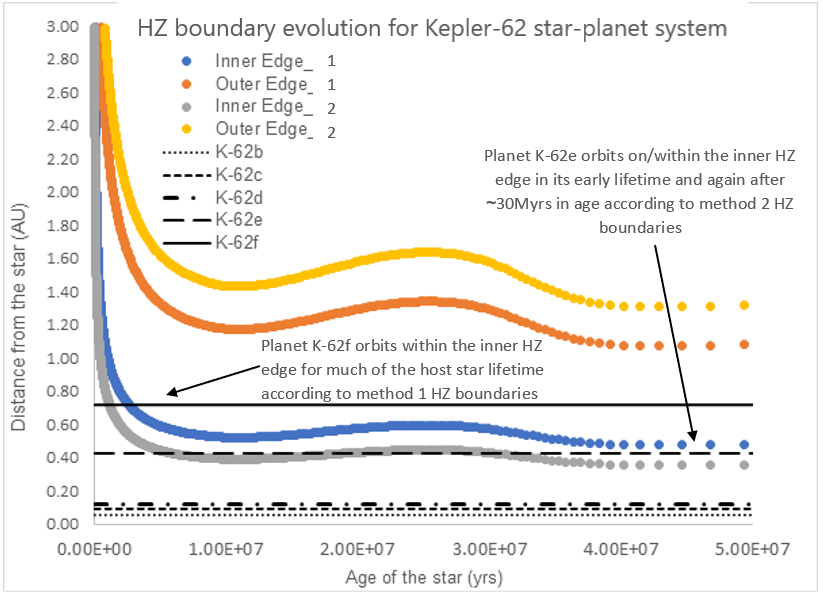Characterising the Potential for Planetary Habitability: A Study of the Temporal Evolution of Exoplanet Habitable Zones
- 1Queen Mary, School of Physics and Astronomy, University of London, United Kingdom of Great Britain – England (jessieh29@hotmail.co.uk)
- 2Birkbeck, School of Earth Sciences, University of London, United Kingdom of Great Britain – England (jessieh29@hotmail.co.uk)
The Habitable Zone (HZ) can be considered plainly as a measure of the potential of planetary habitability or as the parametric region about a star in which surficial water is deemed to be stable on a planet. This potential stability is a direct result of host star flux and effective radiative cooling mechanisms in accordance with the atmospheric greenhouse effect of orbiting planets. This stellar flux varies in conjunction with the temporal evolution of the host star.
Hence, we conduct the modelling of the Main Sequence (MS) and pre-MS phases of HZ evolution in order to characterise the habitability of 6 exoplanetary systems with FGK-Type host stars. In addition to this, 1 M⊙ hypothetical stars were modelled with fluctuating albedo and metallicity values to characterise the relationship of certain stellar and planetary parameters on temporal HZ evolution, to better calibrate the characterisation of exoplanet habitability in general for a diverse range of planets. This is a tool to allow us to make predictions about when or if these planets modelled are potentially habitable now, have previously been or will be in the future.

Our model simulations allow us to recommend certain exoplanets for further characterisation due to their potential current (or previous) orbit within their respective HZ, assuming they are currently considered or found to be rocky planets. These planets include Tau Ceti e, HD 40307g, Kepler 62f and e. Techniques that could be used to investigate these planets may be characterisation of their atmospheres for biosignatures using modelling of atmospheric composition to evaluate their habitability further, as situation within the HZ does not necessarily mean a planet is habitable. HZ planets, in relatively close proximity to the Earth and situated far enough from their host star to be resolved, should be probed using direct imaging to investigate surface environments, critical near-surficial conditions that may influence the stability of liquid water.

Potential future telescopes suitable for these recommendations would be the Habitable Exoplanet Imaging Mission (HabEx) and the Large Ultraviolet Optical Infrared Surveyor (LUVOIR) (Arney et al., 2018).
A major conclusion from the investigation of a 1 M⊙ hypothetical star reveals the potential for a closer inner HZ edge than formerly estimated (0.325 AU from the host star when albedo (A) = 0.9 in this work). The repercussions of this updated estimate imply that if a closely orbiting planet with a high albedo is found to orbit its host star, it may still be habitable and should not be neglected in terms of its habitability prospects. This also extends the frequency of habitable exoplanets if the inner edge of the HZ truly can exist at close proximity to the host star in question, having repercussions on exoplanet characterisation as a whole if these HZ distances can be replicated in subsequent works or verified by rocky exoplanet observations.
Furthermore, our results reinstate that a tidal-locking scenario is likely to shorten the width of the HZ significantly and draw it closer to the host star – introducing constraints for rocky bodies that may be considered habitable. This is significant when considering planets orbiting beyond the inner edge of the HZ and re-evaluation of their habitability may be necessary once atmospheric, albedo and other orbital data for exoplanetary systems can be determined.
Previous HZ publications have centred around MS habitability (Kasting et al., 1993; Kopparapu et al., 2013), yet the temporal evolution of the HZ is becoming more widely recognised as fundamental in evaluating habitability as a whole (Ramirez and Kaltenegger, 2014; Danchi and Lopez, 2013). Pre-MS evolution is a deciding factor as to whether planets are still habitable during the MS phase – planets within the pre-MS HZ are unchartered targets in the search for habitable worlds or even as tools to decipher habitable planet diversity and early water delivery mechanisms. Such results should be utilised as a first order estimation of exoplanetary habitability.
To summarise, there is still significant progress left to be made in calculating reliable HZ boundaries and to then characterise the habitability of planets orbiting within them. Nevertheless, these HZ boundaries serve as a critical basis for the assessment of the habitability of modelled exoplanetary systems. Such works are beneficial as they may result in the detection of habitable exoplanets suitable for observational follow-ups, or even to the eventuality of discovering evidence for extra-terrestrial life.
References:
- Arney, G., Batalha, N., Cowan, N., Domagal-Goldman, S., Dressing, C., Fujii, Y., Kopparapu, R., Lincowski, A., Lopez, E., Lustig-Yaeger, J. and Youngblood, A., 2018. The Importance of Multiple Observation Methods to Characterize Potentially Habitable Exoplanets: Ground-and Space-Based Synergies. arXiv preprint arXiv:1803.02926.
- Danchi, W.C. and Lopez, B., 2013. Effect of Metallicity on the Evolution of the Habitable Zone from the Pre-main Sequence to the Asymptotic Giant Branch and the Search for Life. The Astrophysical Journal, 769(1), p.27.
- Kasting, J., Whitmire, D. and Reynolds, R., 1993. Habitable Zones around Main Sequence Stars. Icarus, 101(1), pp.108-128.
- Kopparapu, R., Ramirez, R., Kasting, J., Eymet, V., Robinson, T., Mahadevan, S., Terrien, R., Domagal-Goldman, S., Meadows, V. and Deshpande, R., 2013. HABITABLE ZONES AROUND MAIN-SEQUENCE STARS: NEW ESTIMATES. The Astrophysical Journal, 765(2), p.131.
- Ramirez, R.M. and Kaltenegger, L., 2014. The habitable zones of pre-main-sequence stars. The Astrophysical Journal Letters, 797(2), p.L25.
How to cite: Hogan, J.: Characterising the Potential for Planetary Habitability: A Study of the Temporal Evolution of Exoplanet Habitable Zones, Europlanet Science Congress 2022, Granada, Spain, 18–23 Sep 2022, EPSC2022-369, https://doi.org/10.5194/epsc2022-369, 2022.

